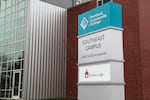
Portland Community College saw an enrollment decline of over 7,000 students from 2019 to 2020, according to the Higher Education Coordinating Commission.
Bryan M. Vance / OPB
Clatsop Community College has lost more than half of its student population in the last year. The college enrolled 1,662 students in 2019, while its Fall 2020 enrollment fell to 784, according to data recently released by the Higher Education Coordinating Commission.
The Astoria-based community college isn’t alone in its enrollment struggles, however. Higher education has taken a hit statewide, with the total number of students at public universities falling 3.8% from 2019. Community colleges have been hit especially hard, though. The community college student population fell 23% across Oregon — more than five times the amount at public universities.
Even prior to the pandemic, many community college students struggled to make ends meet. Portland Community College President Mark Mitsui said PCC participated in a research study out of Temple University that found over 60% of its students struggled with basic needs insecurity before COVID-19. Over 40% struggled with food insecurity, and 19% dealt with homelessness. Now, 60% of students have job insecurity on top of basic needs insecurity, Mitsui told OPB’s “Think Out Loud.” A third of PCC’s students are unemployed.
Mitsui anticipates the enrollment levels will return to normal levels eventually, based on previous trends. After the Great Recession in the early 2000s, enrollment began to increase again about 18 months into the recession.
At Clatsop Community College, the second smallest community college in Oregon, Vice President of Student Success Jerad Sorber partly attributes the college’s steep enrollment decline to the significant rural population it serves.
Related: ‘Losing a generation’: Fall college enrollment plummets for 1st-year students
“We’ve had some major issues around rural connectivity,” Sorber told “Think Out Loud.” The fastest internet speed he can receive at his own home is only 3 megabits per second.
In addition to connectivity issues, Sorber said some of the college’s students who work, such as grocery store employees, have found themselves picking up extra hours and cannot make time for school. Others are occupied with taking care of their families at home.
“We live in a childcare desert, so for those who are trying to manage having little ones at home, that they’re helping out with their own studies — it starts becoming a little bit of a bridge too far for some of our students,” Sorber said.
While the enrollment drop at Clatsop Community College has forced Sorber and his colleagues to tread the financial line carefully, it’s also been a reminder of why the college exists: To serve the community.
“We actually have a vital role to play in the economic revitalization of our area as the pandemic ends, and as we move forward,” Sorber said.
As COVID-19 vaccine distribution continues, community colleges now have the responsibility of identifying which job sectors will come back strongly and adjusting their programs accordingly.
Related: No increases proposed in budget for Oregon’s community colleges, public universities
“Every recession and recovery cycle, there is structural job loss, and there is an increased skill requirement for the jobs that come back,” Mitsui said.
For now, Mitsui’s focus is on an equitable recovery. He knows that students will come back to PCC, but he wants to make sure that tuition is low enough so community college remains accessible. For that to happen, he said, they need investment from the state government.
Contact “Think Out Loud®”
If you’d like to comment on any of the topics in this show, or suggest a topic of your own, please get in touch with us on Facebook or Twitter, send an email to thinkoutloud@opb.org, or you can leave a voicemail for us at 503-293-1983. The call-in phone number during the noon hour is 888-665-5865.
